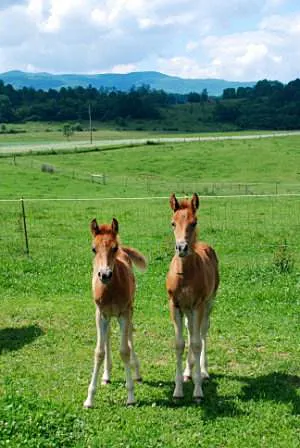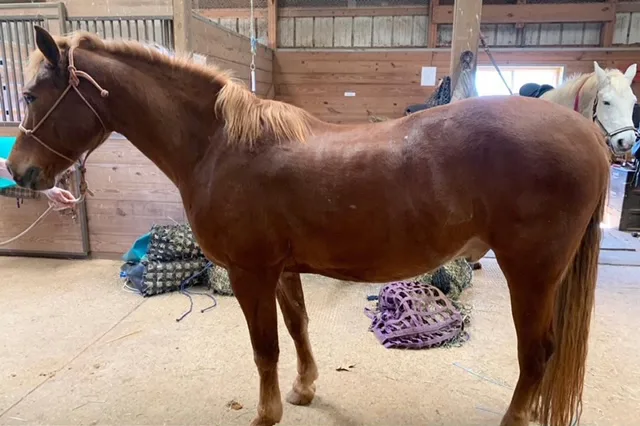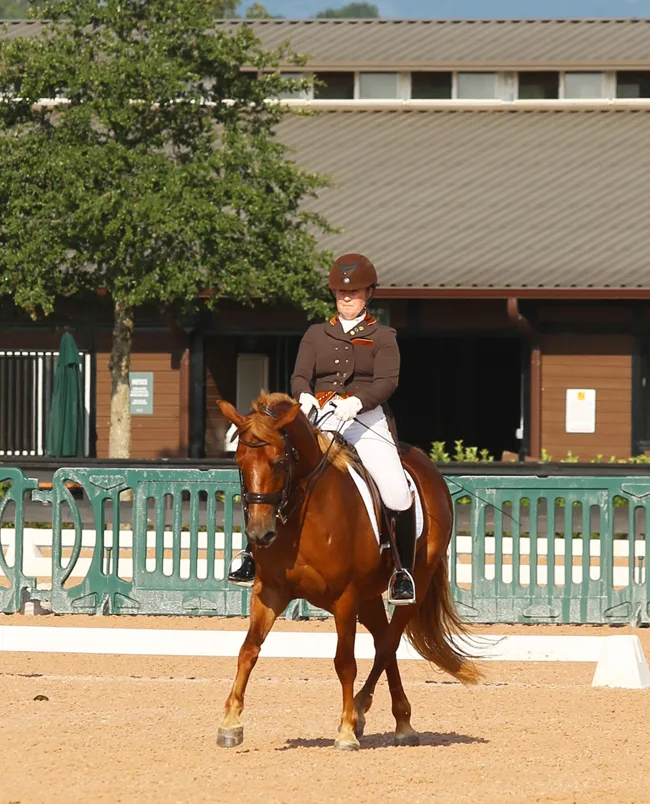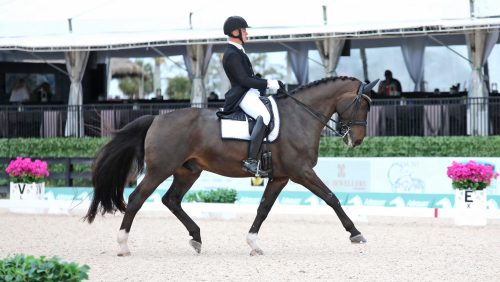Amongst the towering warmbloods showing off their paces at the Tryon International Equestrian Center in 2020, a sturdy little Morgan stood out. The chestnut gelding may not have had the European pedigree of his competitors, but that didn’t stop Quietude Seneca Rocks from placing first and second in his first Intermediaire I tests with rider Elaine Hayes.
Hayes first set eyes on “Seneca,” when he was an ungainly yearling. Now 12, he’s developed strength and coordination with good training, but he never outgrew that awkwardness. He measures 15.1 hands behind, but at the withers he’s a pony. His downhill build doesn’t suggest an aptitude for dressage, and if anyone had told Hayes back then that he would one day become her FEI partner, she would’ve laughed.

Morgan gelding Quietude Seneca Rocks proved he can hold his own in the FEI classes with Elaine Hayes at the Tryon International Equestrian Center. Amber Heintzberger Photo
Seneca’s owner, Ruth Shaw, bred him on something of a whim. His story began when Ruth and her husband, Colin Shaw, purchased a property in West Virginia as a getaway from their home in Davidson, North Carolina, about 12 miles from Hayes’ barn at the Lake Norman Dressage Center in Mooresville, North Carolina.
Ruth, 72, prefers to trail ride and enjoy the scenery from horseback. “It’s one of the most beautiful spots in the world,” she said of her West Virginia farm, which is in Pocahontas County. “You can ride for miles in the mountains there.”
Colin died in 2020, 3 ½ weeks after receiving a cancer diagnosis. “I took my horse to West Virginia after he passed and rode on the trails, and it was spiritually renewing that there could still be joy in life,” Ruth said.
The property is across the road from the Quietude Stud, which produces Morgans, mainly for pleasure riding. “They really devoted their lives to foundation horses, particularly the Lambert Horses, which all descended from a stallion called Daniel Lambert,” said Ruth. “They have to trace back to him on the sire line. They brought that line of horses back from near extinction and have exported horses to Australia and Switzerland.”
Her mare, Quietude Kendal, came with the house, and Morgan stallion Calcutta Of Quietude lived across the street. “I realize I’m being quite anthropomorphic, but it was really a love story,” Ruth said. “Those horses loved each other, so I bred my mare. I produced Seneca to be a trail horse for me; I didn’t really need another horse, but I fell in love with the combination of those two horses. The stallion died not too long after Seneca was born.”

Owner Ruth Shaw bred Quietude Seneca Rocks (right) to be her trail horse, but he chose a different career. Photo Courtesy Of Elaine Hayes
Shaw continued with a laugh, “We told every joke about Seneca being the hillbilly horse, ‘Higher on one end than the other because he couldn’t get off the mountain,’ but he doesn’t know he’s not a big horse! My mare is a far-better made horse, but she’d rather be beaten than go to a show. She absolutely hates it, whereas Seneca has a great work ethic. He puts on a little strut and just loves it.”
ADVERTISEMENT
However, Seneca’s sport horse career got off to a rocky start. He was badly injured as a yearling when he got caught in high-tensile wire that was hidden under a snowbank. After Seneca recovered, Ruth sent him to South Carolina to learn to drive, and he had another accident and ended up on stall rest once again. Ruth believes dressage is a good foundation for every horse, so Seneca went to Hayes for training under saddle.
“She told me she’d had him bred just for her, and I literally said, ‘Why?’ ” recalled Hayes. “But then we thought, ‘OK, he’s young; he’ll grow,’ and it just never happened.”
Like many undersized equines, Seneca makes up for his stature with his strength of will. “I do groundwork and horsemanship as well as dressage training, and he’s the only horse that ever got me out of my big 75 x 200 foot arena,” said Hayes. “ He dragged my butt out the door not once but twice! I was trying to yield his front end or something, and he was pretty strong. If you had told me at that point that he’d even make it past second level, I’d have said, ‘No way!’ ”
Hayes saw a glimmer of his potential when she showed him as a 4-year-old at training level for scores of 75%. He’s moved up a level every 1 ½ years or so since. “He really loves to work; he hates having time off,” Hayes said. “I think that the work actually makes him physically feel good.”
Each time he moved up, Hayes thought, “This is the end; this is as far as he’ll go.” But every time he just gets better.
“The changes were super hard, and his canter is terrible, but then eventually he just learns it,” Hayes said. “I literally couldn’t get him to canter on the right lead—we even had the vet out—and to the left he had this crazy, egg-beater canter. I just kept trying, and it took about two months. His stifles are kind of his weakness because he’s so downhill, and he has a large rear and an active hind leg that comes into this downhill frame. It has the effect of being swaybacked because he’s so low in front.

Quietude Seneca Rocks’ conformation isn’t ideal for dressage, but with good training, he’s been able to move up the levels to Intermediaire I. Photo Courtesy Of Elaine Hayes
“We just went sideways in the canter a lot, and it was terrible for months and months, but like everything else he got a little better and better,” she continued. “He was really struggling with the half-pirouette in the Prix St. Georges, but by the end of the year he was getting 7s. Ruth is a great owner and wants to do what’s best for him and is supportive of me. She’s competitive, too, so you’d think she’d buy a big fancy dressage horse, but she loves the little Morgans. I have to say they’ve won me over, too.”
Ruth has ridden since childhood on various breeds and in different disciplines. “I had an intense career and then in my 50s came to warmbloods,” she said. “I’m a short woman and ended up on a tall horse and knew I needed something smaller. I also was coming to the dawning awareness I really enjoyed being outside on a horse, and I investigated smaller breeds and found the Morgans. They’re very versatile.
ADVERTISEMENT
“I’ve loved every horse I’ve had, but I really like this breed,” she continued. “I will say so much in our sport is women coming to riding or returning to riding. Morgans make a great mount for that group of people who for the most part need a milder temperament and a smaller size than comes in some of the other breeds. You can get a great horse that can do a lot of things in a tidy little package, and they’re hardy, sound horses.”
Ruth didn’t intend for Seneca to become a dressage competitor; he chose it for himself. “He’s got one of the biggest personalities, and he’s just a little workhorse!” she said. “He loves to show, and if he didn’t love it we wouldn’t do it.”
Hayes agreed. “He loves getting on the trailer and going to shows. Bigger horses can thunder past in the warm-up, and he’s not intimidated by anything,” she said. “He’s like a little Napoleon. He believes he’s a Grand Prix horse, and I have learned to not guess his limits.”
Ruth has ridden Seneca on the trails in West Virginia, but he tends to get a little “bored and feisty.” Her 7-year-old granddaughter also rides him, and Hayes said, “He’ll teach anyone to do a flying change or a half-pass, but he’s still super plain if you let him be.”

“He’s like a little Napoleon,” said Elaine Hayes of Quietude Seneca Rocks. “He believes he’s a Grand Prix horse, and I have learned to not guess his limits.” Amber Heintzberger Photo
Seneca is working toward Grand Prix, with his piaffe and one-tempis already in place. But his progress got derailed last year when he got in a kicking fight with a pony in March and broke his splint bone. “Ruth immediately thought we’d have to retire him, but it was the height of COVID, so there were no shows anyway,” said Hayes. “He got laminitic on stall rest because he’s super metabolic—working really helps his whole system. A month before the show was the first time he cantered.
“I took him to Tryon because I needed a qualifying score to do the freestyle,” continued Hayes. “We already set regionals as a little goal, so we needed to get moving. Chris Hickey is my coach, and he thought I was crazy. But Seneca pulled it together. He’s so reliable it’s like money in the bank. He’s a blessing for sure.”
Whenever Hayes shows Seneca, people come up to her to compliment the little Morgan. “Dressage doesn’t have to be so serious, though in his case it’s definitely improved his life and his longevity,” said Hayes. “He inspires me, literally. I wish I could say that I knew all along he would be a champion; I still don’t know if he can do the Grand Prix, but he goes to work every day. He’s the kind of horse that comes to the stall door, whoever’s there, and he’s a good boy.”














